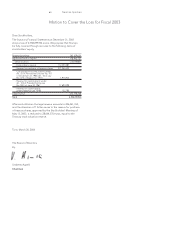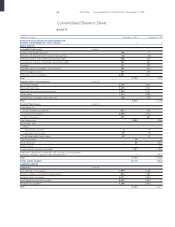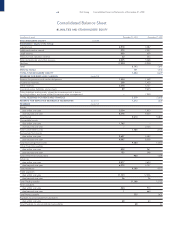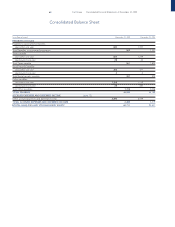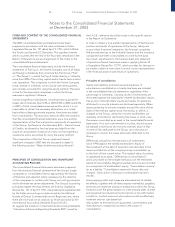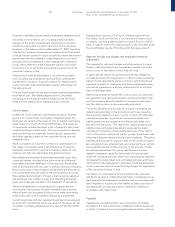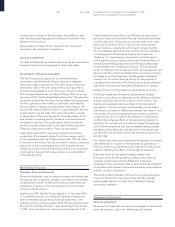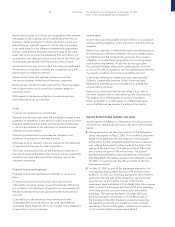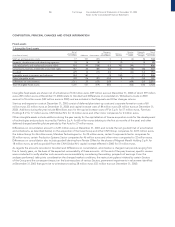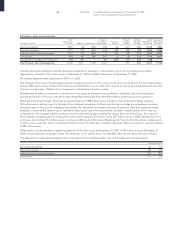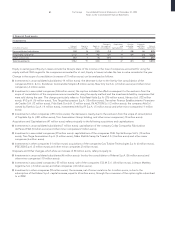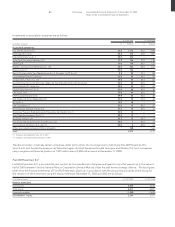Chrysler 2003 Annual Report Download - page 74
Download and view the complete annual report
Please find page 74 of the 2003 Chrysler annual report below. You can navigate through the pages in the report by either clicking on the pages listed below, or by using the keyword search tool below to find specific information within the annual report.
73 Fiat Group Consolidated Financial Statements at December 31, 2003
FORM AND CONTENT OF THE CONSOLIDATED FINANCIAL
STATEMENTS
The 2003 consolidated financial statements have been
prepared in accordance with the rules contained in Italian
Legislative Decree No. 127 dated April 9, 1991, which fulfilled
the Fourth and Seventh EC Directives. The significant events
which occurred after the end of the fiscal year described in the
Report of Operations are an integral part of the notes to the
consolidated financial statements.
The consolidated financial statements include the financial
statements of Fiat S.p.A., the Parent Company, and of all Italian
and foreign subsidiaries that constitute the Fiat Group (“Fiat”
or “The Group”), in which Fiat S.p.A. holds directly or indirectly
more than 50% of the voting capital and/or has de facto control
over operations. The companies in which the Parent Company
holds, directly or indirectly, control jointly with other partners,
are normally accounted for using the equity method. The same
is true for the associated companies in which the Group
exercises a significant influence.
Certain insignificant subsidiaries, including those acquired for
resale, which total less than 0.3% in 2003 (0.5% in 2002 and 0.6%
in 2001) of total consolidated revenues and for which it is not
practicable to obtain the necessary information on a timely
basis without disproportionate expense, have been excluded
from consolidation. This exclusion does not affect the assertion
that the consolidated financial statements are a true and fair
representation of the financial position and results of operations
of the Group. Furthermore, the subsidiary BUC – Banca Unione
di Credito, as allowed by law, has been excluded from the
scope of consolidation inasmuch as it has non-homogeneous
operations and is accounted for using the equity method.
The composition of the Fiat Group underwent several
significant changes in 2003 that are discussed in detail in
the following section “Major divestitures during the year”.
PRINCIPLES OF CONSOLIDATION AND SIGNIFICANT
ACCOUNTING POLICIES
The consolidated financial statements have been prepared
from the statutory financial statements of the Group’s single
companies or consolidated Sectors approved by the Boards
of Directors and adjusted, where necessary, by the directors
of the companies to conform with Group accounting principles
and to eliminate tax-driven adjustments. The Group’s accounting
principles respect the requirements set forth by Legislative
Decree No. 127 of April 9, 1991, interpreted and supplemented
by the Italian accounting principles issued by the National
Boards of Dottori Commercialisti and of Ragionieri and, where
there are none and not at variance, by those laid down by the
International Accounting Standards Board (I.A.S.B.).
As regards the transition to International Accounting Standards
“International Financial Reporting Standards IFRS” issued by
Notes to the Consolidated Financial Statements
at December 31, 2003
the I.A.S.B., reference should be made to the specific section
in the Report on Operations.
In order to obtain a true and fair representation of the financial
position and results of operations of the Group, taking into
account their functional integration, the financial companies
that provide services to the industrial Sectors and the insurance
companies have been consolidated on a line-by-line basis.
As a result, adjustments to the balance sheet and statement
of operations format have been made in applying Article 32
of Legislative Decree No. 127/91, which provides for changes to
be made to obtain a more clear, true and correct representation
of the financial position and results of operations.
Principles of consolidation
Assets and liabilities, and revenues and expenses, of
subsidiaries consolidated on a line-by-line basis are included
in the consolidated financial statements, regardless of the
percentage of ownership. Carrying values of investments are
eliminated against the subsidiaries’ related stockholders’ equity.
The portion of stockholders’ equity and results of operations
attributed to minority interests are disclosed separately. When
losses pertaining to minority interests exceed the value of their
share of the relevant capital stock, the excess, or deficit, is
charged to the Group, unless the minority stockholders are
expressly committed to reimbursing the losses, in which case
the excess is recorded as an asset in the consolidated financial
statements. If no such commitment is in place, should income
be realized in the future, the minority interests’ share of that
income will be attributed to the Group, up to the amount
necessary to recover the losses previously attributed to the
Group.
Differences arising from the elimination of investments
(since 1994) against the related stockholders’ equity of
the investment at the date of acquisition are allocated to the
assets and liabilities of the company being consolidated, up
to the limit of their current value. The residual value, if positive,
is capitalized as an asset, “Differences on consolidation”,
and is amortized on the straight-line basis over the estimated
period of recoverability. Negative residual amounts are recorded
as a component of stockholders’ equity, “Consolidation reserve”
(or as a liability, “Consolidation reserve for future risks and
charges”, when due to a forecast of unfavorable economic
results).
Intercompany profits and losses are eliminated net of related
tax effects, together with all intercompany receivables, payables,
revenues and expenses arising on transactions within the Group.
Exceptions are the gross margins on intercompany sales of plant
and equipment produced and sold at prices in line with market
conditions, in which case such eliminations would be effectively
irrelevant and not cost-beneficial.
Also subject to elimination are guarantees, commitments and
risks relating to companies included in the scope of
consolidation.


